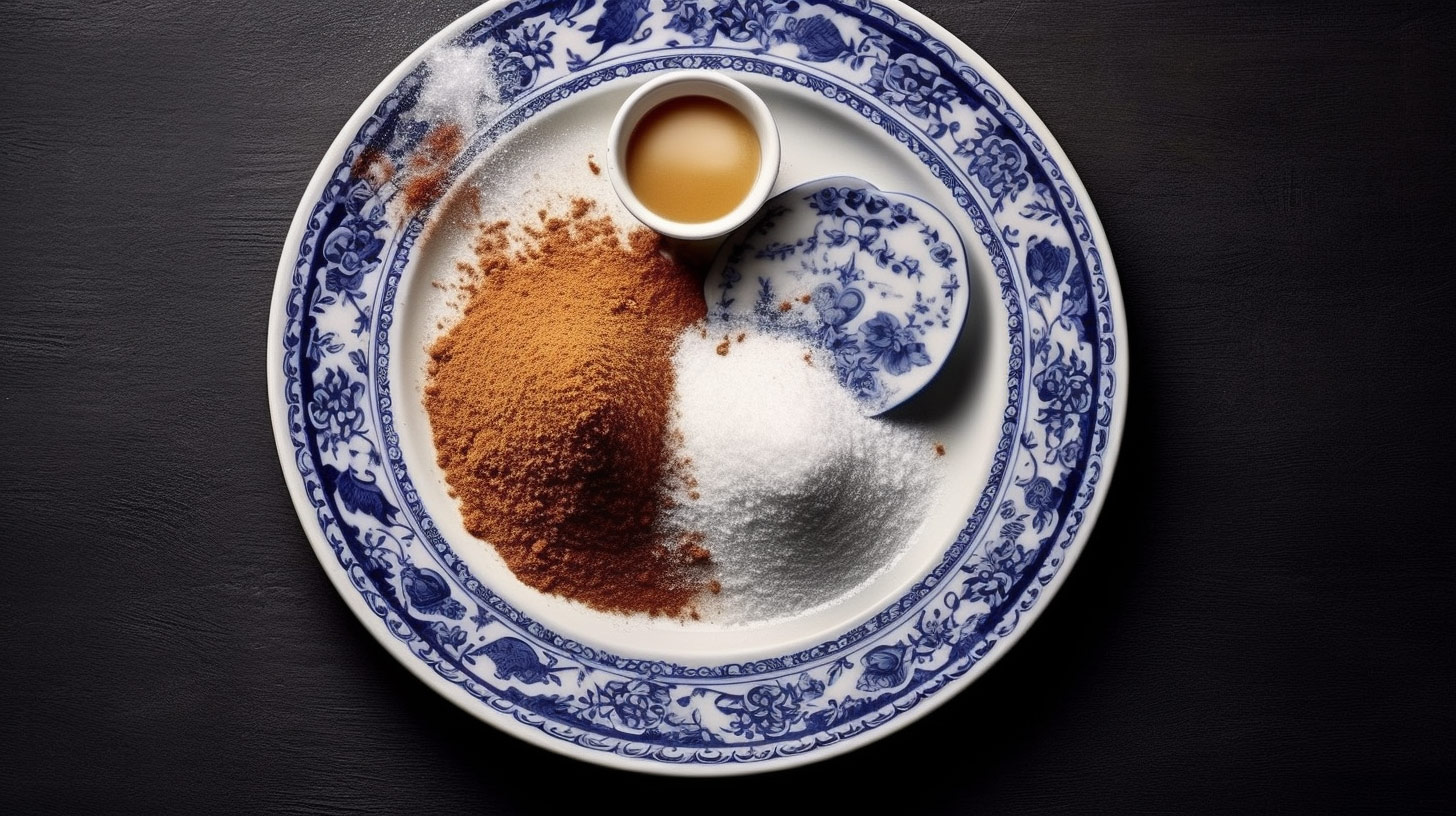When it comes to sweetening our favorite foods and beverages, sugar is the go-to choice for many people. However, in recent years, brown sugar has gained popularity as a perceived healthier alternative. In this article, we will delve into the comparison between sugar and brown sugar, exploring their nutritional profiles, potential health benefits, and considerations for making a healthier choice. Let’s find out which one is truly better for our health.
Understanding the Basics:
Before diving into the debate, it’s important to understand the fundamental differences between sugar and brown sugar. Sugar, also known as table sugar or white sugar, undergoes a refining process that removes impurities and molasses, resulting in its characteristic white appearance. Brown sugar, on the other hand, retains some molasses, lending it a slightly darker color and distinctive flavor.
Nutritional Composition:
In terms of their nutritional profiles, sugar and brown sugar are quite similar. Both are primarily composed of carbohydrates and contain the same amount of calories per serving. However, the small amount of molasses present in brown sugar adds a trace amount of minerals like calcium, potassium, iron, and magnesium. While these minerals are present in minuscule quantities and do not significantly impact overall nutrition, it is worth noting the slight difference.
White Sugar:
- Contains 99.9% sucrose
- Lacks essential nutrients
- High glycemic index
Brown Sugar:
- Contains 95% sucrose and 5% molasses
- Contains small amounts of minerals like calcium, potassium, and iron
- Moderate glycemic index
Processing Methods
The key difference between white sugar and brown sugar lies in their processing methods.
Sugar Processing:
Regular granulated sugar, also known as white sugar, undergoes an extensive refining process to remove impurities and extract pure sucrose. The processing steps typically involve the following:
a. Extraction: Sugarcane or sugar beets are crushed to extract the juice containing sucrose.
b. Purification: The extracted juice undergoes purification through filtration and the addition of lime to remove impurities.
c. Concentration: The purified juice is heated and boiled to evaporate the water, resulting in a concentrated syrup.
d. Crystallization: The concentrated syrup is cooled and seeded with sugar crystals, which promotes the growth of larger sugar crystals.
e. Centrifugation: The sugar crystals are separated from the remaining liquid in a centrifuge.
f. Drying and Packaging: The separated sugar crystals are dried and packaged, resulting in the final granulated sugar product.
Brown Sugar Processing:
Brown sugar is less refined compared to white sugar, as it retains some of the natural molasses content. The processing methods for brown sugar are as follows:
a. Extraction and Purification: The initial steps of extracting and purifying the sugarcane or sugar beet juice are similar to those in white sugar processing.
b. Addition of Molasses: After purification, a portion of the molasses removed during the refining process is added back to the sugar crystals.
c. Mixing and Drying: The sugar crystals are mixed with the added molasses, creating a moist and sticky mixture.
d. Granulation: The moist mixture is then granulated, resulting in brown sugar with its characteristic color, flavor, and slightly coarser texture.
It’s important to note that the processing methods may vary slightly depending on the manufacturer and region. However, the general principles of extraction, purification, and crystallization remain consistent in both sugar and brown sugar production.
By understanding the processing methods, consumers can make informed choices based on their preferences and dietary needs.

Glycemic Index and blood Sugar Impact:
The glycemic index (GI) is a measure of how quickly a particular food raises blood sugar levels. Both sugar and brown sugar have a high glycemic index, meaning they can cause a rapid spike in blood sugar levels when consumed. This can have negative implications for individuals with diabetes or those aiming to control their blood sugar levels. In such cases, alternative sweeteners with lower glycemic index values may be more suitable.
Impact on Weight Management:
Excessive consumption of sugar, regardless of its color, can contribute to weight gain and obesity. Sugar provides empty calories and lacks essential nutrients, making it easy to exceed daily calorie limits without feeling satiated. While brown sugar’s minimal mineral content may offer some negligible health benefits, its impact on weight management is comparable to that of regular sugar. Moderation and mindful portion control are key for both options.
White Sugar:
- High glycemic index (around 65-100)
- Rapidly raises blood sugar levels
Brown Sugar:
- Moderate glycemic index (around 55-65)
- Raises blood sugar levels more slowly compared to white sugar
Antioxidant Content:
Molasses, the component that gives brown sugar its color, contains trace amounts of antioxidants. Antioxidants help neutralize harmful free radicals in the body, potentially reducing the risk of chronic diseases. However, the concentration of antioxidants in brown sugar is minimal and not sufficient to outweigh the negative effects of excessive sugar consumption. It’s important to focus on obtaining antioxidants from whole, nutrient-dense foods rather than relying on brown sugar as a source.
Making Healthier Choices:
When it comes to sweeteners, moderation is key. Reducing overall sugar intake, regardless of the type, is essential for maintaining good health. However, there are healthier alternatives to consider. Natural sweeteners like honey, maple syrup, or stevia offer distinct flavors and may provide additional nutritional benefits. These alternatives are often less processed and contain some trace minerals or antioxidants, making them preferable options for those seeking a healthier lifestyle.
Which one is better choice for children?
When it comes to choosing between sugar and brown sugar for children, it’s important to note that both should be consumed in moderation. Excessive sugar intake, regardless of the type, can have negative health effects on children. However, if used sparingly, both sugar and brown sugar can be incorporated into a balanced diet.
Here are a few considerations:
- Nutrient Content:
Brown sugar contains slightly higher levels of minerals like calcium, potassium, iron, and magnesium due to the presence of molasses. While the difference is not significant, these minerals can provide some nutritional value. However, it’s important to remember that the quantities of these minerals in brown sugar are relatively small, and they can be obtained through other more nutrient-rich food sources.
- Taste and Palatability:
Children often have a preference for sweet flavors. Introducing small amounts of sugar or brown sugar can make certain foods more appealing and encourage children to consume nutritious foods they might otherwise reject. However, it’s crucial to limit their overall sugar intake and promote a diverse range of flavors in their diet.
- Dental Health:
Both sugar and brown sugar can contribute to tooth decay if consumed in excess or not properly managed. It’s essential to teach children good oral hygiene practices, such as regular brushing and flossing, and limit their consumption of sugary foods and beverages, including those with added sugars.
- Alternatives:
Consider exploring healthier alternatives to sugar and brown sugar for children. Natural sweeteners like pureed fruits, mashed bananas, or unsweetened applesauce can be used to add sweetness to recipes. These alternatives provide additional nutrients and fiber while reducing the overall sugar content.
- Overall Diet:
The focus should be on providing children with a well-balanced diet consisting of whole, unprocessed foods, including fruits, vegetables, whole grains, lean proteins, and healthy fats. Sugar, in any form, should be viewed as an occasional treat rather than a dietary staple.
In conclusion, neither sugar nor brown sugar is a significantly better choice for children. The key is moderation and promoting a well-rounded diet. Parents should be mindful of the total sugar intake of their children, encourage healthy eating habits, and explore alternative ways to add sweetness to meals and snacks.
Conclusion:
In the sugar versus brown sugar debate, there is no clear winner in terms of health benefits. Both options have similar nutritional compositions and can negatively impact weight management and blood sugar levels when consumed in excess. To make healthier choices, it’s advisable to limit overall sugar intake and explore alternative natural sweeteners. Remember, maintaining a balanced diet that focuses on whole, nutrient-rich foods is the key to optimal health.
By incorporating moderation, portion control, and exploring healthier alternatives, you can make informed decisions about your sugar intake and enjoy sweet treats while prioritizing your health.
FAQ
Is sugar bad for my health?
Excessive sugar intake can have negative health effects. Moderation is key.
Does brown sugar offer more health benefits than regular sugar?
Brown sugar contains slightly more minerals, but the difference is minimal. Both should be consumed sparingly.
Can children consume sugar?
Yes, in moderation. It’s important to promote a balanced diet and limit overall sugar intake.
Are there healthier alternatives to sugar?
Yes, natural sweeteners like honey, maple syrup, and stevia can be used in moderation.
Can sugar cause tooth decay?
Yes, excessive sugar consumption, regardless of the type, can contribute to tooth decay. Good oral hygiene is essential.
When it comes to sweetening our favorite foods and beverages, sugar is the go-to choice for many people. However, in recent years, brown sugar has gained popularity as a perceived healthier alternative. In this article, we will delve into the comparison between sugar and brown sugar, exploring their nutritional profiles, potential health benefits, and considerations for making a healthier choice. Let’s find out which one is truly better for our health.
Understanding the Basics:
Before diving into the debate, it’s important to understand the fundamental differences between sugar and brown sugar. Sugar, also known as table sugar or white sugar, undergoes a refining process that removes impurities and molasses, resulting in its characteristic white appearance. Brown sugar, on the other hand, retains some molasses, lending it a slightly darker color and distinctive flavor.
Nutritional Composition:
In terms of their nutritional profiles, sugar and brown sugar are quite similar. Both are primarily composed of carbohydrates and contain the same amount of calories per serving. However, the small amount of molasses present in brown sugar adds a trace amount of minerals like calcium, potassium, iron, and magnesium. While these minerals are present in minuscule quantities and do not significantly impact overall nutrition, it is worth noting the slight difference.
White Sugar:
- Contains 99.9% sucrose
- Lacks essential nutrients
- High glycemic index
Brown Sugar:
- Contains 95% sucrose and 5% molasses
- Contains small amounts of minerals like calcium, potassium, and iron
- Moderate glycemic index
Processing Methods
The key difference between white sugar and brown sugar lies in their processing methods.
Sugar Processing:
Regular granulated sugar, also known as white sugar, undergoes an extensive refining process to remove impurities and extract pure sucrose. The processing steps typically involve the following:
a. Extraction: Sugarcane or sugar beets are crushed to extract the juice containing sucrose.
b. Purification: The extracted juice undergoes purification through filtration and the addition of lime to remove impurities.
c. Concentration: The purified juice is heated and boiled to evaporate the water, resulting in a concentrated syrup.
d. Crystallization: The concentrated syrup is cooled and seeded with sugar crystals, which promotes the growth of larger sugar crystals.
e. Centrifugation: The sugar crystals are separated from the remaining liquid in a centrifuge.
f. Drying and Packaging: The separated sugar crystals are dried and packaged, resulting in the final granulated sugar product.
Brown Sugar Processing:
Brown sugar is less refined compared to white sugar, as it retains some of the natural molasses content. The processing methods for brown sugar are as follows:
a. Extraction and Purification: The initial steps of extracting and purifying the sugarcane or sugar beet juice are similar to those in white sugar processing.
b. Addition of Molasses: After purification, a portion of the molasses removed during the refining process is added back to the sugar crystals.
c. Mixing and Drying: The sugar crystals are mixed with the added molasses, creating a moist and sticky mixture.
d. Granulation: The moist mixture is then granulated, resulting in brown sugar with its characteristic color, flavor, and slightly coarser texture.
It’s important to note that the processing methods may vary slightly depending on the manufacturer and region. However, the general principles of extraction, purification, and crystallization remain consistent in both sugar and brown sugar production.
By understanding the processing methods, consumers can make informed choices based on their preferences and dietary needs.



Glycemic Index and blood Sugar Impact:
The glycemic index (GI) is a measure of how quickly a particular food raises blood sugar levels. Both sugar and brown sugar have a high glycemic index, meaning they can cause a rapid spike in blood sugar levels when consumed. This can have negative implications for individuals with diabetes or those aiming to control their blood sugar levels. In such cases, alternative sweeteners with lower glycemic index values may be more suitable.
Impact on Weight Management:
Excessive consumption of sugar, regardless of its color, can contribute to weight gain and obesity. Sugar provides empty calories and lacks essential nutrients, making it easy to exceed daily calorie limits without feeling satiated. While brown sugar’s minimal mineral content may offer some negligible health benefits, its impact on weight management is comparable to that of regular sugar. Moderation and mindful portion control are key for both options.
White Sugar:
- High glycemic index (around 65-100)
- Rapidly raises blood sugar levels
Brown Sugar:
- Moderate glycemic index (around 55-65)
- Raises blood sugar levels more slowly compared to white sugar
Antioxidant Content:
Molasses, the component that gives brown sugar its color, contains trace amounts of antioxidants. Antioxidants help neutralize harmful free radicals in the body, potentially reducing the risk of chronic diseases. However, the concentration of antioxidants in brown sugar is minimal and not sufficient to outweigh the negative effects of excessive sugar consumption. It’s important to focus on obtaining antioxidants from whole, nutrient-dense foods rather than relying on brown sugar as a source.
Making Healthier Choices:
When it comes to sweeteners, moderation is key. Reducing overall sugar intake, regardless of the type, is essential for maintaining good health. However, there are healthier alternatives to consider. Natural sweeteners like honey, maple syrup, or stevia offer distinct flavors and may provide additional nutritional benefits. These alternatives are often less processed and contain some trace minerals or antioxidants, making them preferable options for those seeking a healthier lifestyle.
Which one is better choice for children?
When it comes to choosing between sugar and brown sugar for children, it’s important to note that both should be consumed in moderation. Excessive sugar intake, regardless of the type, can have negative health effects on children. However, if used sparingly, both sugar and brown sugar can be incorporated into a balanced diet.
Here are a few considerations:
- Nutrient Content:
Brown sugar contains slightly higher levels of minerals like calcium, potassium, iron, and magnesium due to the presence of molasses. While the difference is not significant, these minerals can provide some nutritional value. However, it’s important to remember that the quantities of these minerals in brown sugar are relatively small, and they can be obtained through other more nutrient-rich food sources.
- Taste and Palatability:
Children often have a preference for sweet flavors. Introducing small amounts of sugar or brown sugar can make certain foods more appealing and encourage children to consume nutritious foods they might otherwise reject. However, it’s crucial to limit their overall sugar intake and promote a diverse range of flavors in their diet.
- Dental Health:
Both sugar and brown sugar can contribute to tooth decay if consumed in excess or not properly managed. It’s essential to teach children good oral hygiene practices, such as regular brushing and flossing, and limit their consumption of sugary foods and beverages, including those with added sugars.
- Alternatives:
Consider exploring healthier alternatives to sugar and brown sugar for children. Natural sweeteners like pureed fruits, mashed bananas, or unsweetened applesauce can be used to add sweetness to recipes. These alternatives provide additional nutrients and fiber while reducing the overall sugar content.
- Overall Diet:
The focus should be on providing children with a well-balanced diet consisting of whole, unprocessed foods, including fruits, vegetables, whole grains, lean proteins, and healthy fats. Sugar, in any form, should be viewed as an occasional treat rather than a dietary staple.
In conclusion, neither sugar nor brown sugar is a significantly better choice for children. The key is moderation and promoting a well-rounded diet. Parents should be mindful of the total sugar intake of their children, encourage healthy eating habits, and explore alternative ways to add sweetness to meals and snacks.
Conclusion:
In the sugar versus brown sugar debate, there is no clear winner in terms of health benefits. Both options have similar nutritional compositions and can negatively impact weight management and blood sugar levels when consumed in excess. To make healthier choices, it’s advisable to limit overall sugar intake and explore alternative natural sweeteners. Remember, maintaining a balanced diet that focuses on whole, nutrient-rich foods is the key to optimal health.
By incorporating moderation, portion control, and exploring healthier alternatives, you can make informed decisions about your sugar intake and enjoy sweet treats while prioritizing your health.
FAQ
Is sugar bad for my health?
Excessive sugar intake can have negative health effects. Moderation is key.
Does brown sugar offer more health benefits than regular sugar?
Brown sugar contains slightly more minerals, but the difference is minimal. Both should be consumed sparingly.
Can children consume sugar?
Yes, in moderation. It’s important to promote a balanced diet and limit overall sugar intake.
Are there healthier alternatives to sugar?
Yes, natural sweeteners like honey, maple syrup, and stevia can be used in moderation.
Can sugar cause tooth decay?
Yes, excessive sugar consumption, regardless of the type, can contribute to tooth decay. Good oral hygiene is essential.

